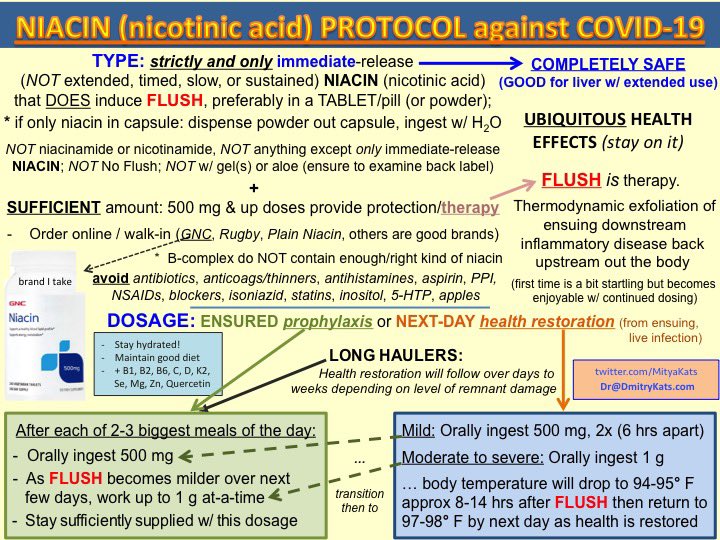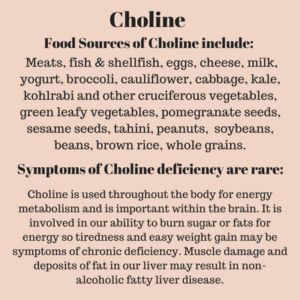The longer a viral infection is allowed to progress the more cells are killed or damaged, either by the viral replication, or by the damaged cells contents harming the surrounding tissue . See for more information: Pathophysiological Basis and Rationale for Early Outpatient Treatment of SARS-CoV-2 (COVID-19) Infection. (1)
See my recent post for a variety of nutrients or other strategies which may help prevent or provide early treatment for a viral infection: COVID19, summary of nutrients that might help prevent, treat, recover.
Niacin in a large dose may help with treatment of an active COVID19 illness or the symptoms of LongCovid. Specifically the niacin/nicotinic acid form, not niacinamide. The “niacin flush” that occurs is warm – and is removing inflammation along with the increased sensation of warmth on the skin. Feeling a little chilled as the niacin flush continues is also normal, internally the body is cooling somewhat as the inflammation is being removed as heat on the skin.
This article summarizes the value of a variety of B vitamins against viral infections and/or inflammation and goes into more detail about niacin use for prevention or treatment of infections and inflammation: Is Niacin a Missing Piece of the COVID Puzzle?. (2) Niacin helps our body cope with increased inflammation and without niacin the inflammation continues to become more severe. For more detail see: Sufficient niacin supply: the missing puzzle piece to COVID-19, and beyond? by Dmitry Kats, PhD (3); and Be Well: A Potential Role for Vitamin B in COVID-19, a team project including scientists from several nations. (4)

shared with permission of the author, Dmitry Kats, PhD.
*The apples and antihistamines can decrease the flush effect if it seems like too much and should be fine at other times of the day, than taken with or shortly after the niacin dose.
Adequate niacin may also help the body have a stable thyroid hormone level. (5)
Low levels of niacin and a metabolite NAD+ may be involved in mitochondrial myopathy which leads to tiredness and weak muscles. Providing 500-1000 milligrams of niacin per day was found to improve muscle strength, increase NAD+ levels to the level seen in the healthy control group, and liver fat decreased by 50% in the experimental group. (6)
Potential short term symptoms – may include serotonin increase.
People who were previously low in serotonin, a neurotransmitter that affects mood and intestinal health, may experience temporary symptoms from an increase in the messenger chemical. Once the body adjusts to the new level of serotonin the symptoms should no longer occur. Symptoms of a sudden increase, or excess of serotonin may include: Agitation or restlessness, Confusion, Rapid heart rate and high blood pressure, Dilated pupils, Loss of muscle coordination or twitching muscles, Muscle rigidity, Heavy sweating, Diarrhea, Headache, Shivering, Goose bumps. (13) People experiencing Serotonin Syndrome for other reasons would likely have more severe symptoms than the short term change due to the increase in niacin. Tryptophan is an amino acid precursor for serotonin and it is depleted when there is inadequate niacin available to make NAD+.
Potential long term risks – may affect liver health and gout – uric acid; quercetin may help reduce risk of uric acid build up.
People with liver damage or gout may need to avoid taking large doses of niacin long term (more than 2000-6000 mg/day). Taking it along with alcohol use may increase the risk of liver damage and worsen the symptoms of the niacin flush with itching. Long term use of large doses may lead to gout, excess uric acid. (7) Symptoms of gout can occur abruptly even waking up at night with severe joint pain, most frequently occurring in the joint at the base of the large toes. Other joint tissue can also be affected. Pain, swelling and redness in the affected toe or other joints are typical symptoms. (8)
Use of large doses of niacin/nicotinic acid for treatment of patients with symptoms of schizophrenia were studied extensively in the 1950s-70s. Use of nicotinamide was not found to help similarly and the treatment was most immediately beneficial for patients with acute onset of the schizophrenia symptoms. People with chronic schizophrenia took longer to respond to use of niacin and needed larger doses to achieve symptom relief. Regarding risk of toxicity, liver concerns, gout, and increases in blood uric acid were observed but were not too severe of a problem, compared to the adverse side effects seen with standard psychiatric medications, and some patients could use a different form or a smaller dose. “The vitamin has been given to patients suffering from gout whose symptoms were not aggravated and it did not interfere with their specific treatment for gout.” (9)
Uric acid/urate levels in gout can be reduces with use of xanthine oxidase inhibitors (10) which include the phytonutrient quercetin. (11) For more information about quercetin’s other benefits as a zinc ionophore and bioflavonoid see the recent post: COVID19, summary of nutrients that might help prevent, treat, recover.
Quercetin is found in many plant foods in small amounts, and rich in some foods like capers (Alcaparras) and cilantro. It is also found in citrus and pomegranate peel. “The researchers note that pickling promotes conversion of rutin (flavonoid compound also called rutoside in capers) to quercetin, the ingredient that they found to be an efficacious KCNQ channel activator. This makes pickled capers as the richest known “natural” source of quercetin, with a maximum reported concentration of 520 mg/100 g for canned capers, compared to a maximum of 323 mg/100 g quercetin for raw capers.” (12) People with Mast Cell overactivity (seasonal allergy & other symptoms might be present) may need to avoid pickled or other fermented foods as that can worsen mast cell symptoms, for more information see: MCAS/Histamine.
Disclaimer: This information is provided for educational purposes within the guidelines of fair use. While I am a Registered Dietitian this information is not intended to provide individual health guidance. Please see a health professional for individual health care purposes.
Reference List
- Peter A. McCullough, MD, MPH. et al., Pathophysiological Basis and Rationale for Early Outpatient Treatment of SARS-CoV-2 (COVID-19) Infection. August 06, 2020 American Journal of Medicine, VOL 134, ISSUE 1, P16-22, JANUARY 01, 2021 DOI:https://doi.org/10.1016/j.amjmed.2020.07.003 https://www.amjmed.com/article/S0002-9343(20)30673-2/fulltext
- Mercol J, Is Niacin a Missing Piece of the COVID Puzzle?, Jan 20, 2021, mercola.com, https://articles.mercola.com/sites/articles/archive/2021/01/20/what-are-the-benefits-of-niacin.aspx
- Kats D, Sufficient niacin supply: the missing puzzle piece to COVID-19, and beyond?, preprint, https://osf.io/uec3r/
- Be Well: A Potential Role for Vitamin B in COVID-19, Maturitas, Shakoor H, Feehan J, Mikkelsen K, et al. Be well: A potential role for vitamin B in COVID-19. Maturitas. 2021;144:108-111. doi:10.1016/j.maturitas.2020.08.007 https://www.ncbi.nlm.nih.gov/pmc/articles/PMC7428453/
- Shakir KM, Kroll S, Aprill BS, Drake AJ 3rd, Eisold JF. Nicotinic acid decreases serum thyroid hormone levels while maintaining a euthyroid state. Mayo Clin Proc. 1995 Jun;70(6):556-8. doi: 10.4065/70.6.556. PMID: 7776715. https://pubmed.ncbi.nlm.nih.gov/7776715/
- Pirinen E, Auranen M, Khan NA, Brilhante V, Urho N, Pessia A, Hakkarainen A, Kuula J, Heinonen U, Schmidt MS, Haimilahti K, Piirilä P, Lundbom N, Taskinen MR, Brenner C, Velagapudi V, Pietiläinen KH, Suomalainen A. Niacin Cures Systemic NAD+ Deficiency and Improves Muscle Performance in Adult-Onset Mitochondrial Myopathy. Cell Metab. 2020 Jun 2;31(6):1078-1090.e5. doi: 10.1016/j.cmet.2020.04.008. Epub 2020 May 7. Erratum in: Cell Metab. 2020 Jul 7;32(1):144. PMID: 32386566. https://pubmed.ncbi.nlm.nih.gov/32386566/
- Niacin, mayoclinic.org, https://www.mayoclinic.org/drugs-supplements-niacin/art-20364984
- Gout – Symptoms & Causes, mayoclinic.org, https://www.mayoclinic.org/diseases-conditions/gout/symptoms-causes/syc-20372897
- Hoffer A, Megavitamin B-3 Therapy for Schizophrenia, Canad. Psychiat. Ass. J. Vol. 16 (1971) https://journals.sagepub.com/doi/pdf/10.1177/070674377101600605
- White WB, Gout, Xanthine Oxidase Inhibition, and Cardiovascular Outcomes. Circulation. 2018;138:1127–1129 https://www.ahajournals.org/doi/10.1161/CIRCULATIONAHA.118.036148
- Zhang C, Wang R, Zhang G, Gong D. Mechanistic insights into the inhibition of quercetin on xanthine oxidase. Int J Biol Macromol. 2018 Jun;112:405-412. doi: 10.1016/j.ijbiomac.2018.01.190. Epub 2018 Jan 31. PMID: 29410028. https://pubmed.ncbi.nlm.nih.gov/29410028/
- Kim Stewart, Discovery: Caper Berry’s Quercetin Activates KCNQ Potassium Channel. July 16, 2020, todayspractitioner.com https://todayspractitioner.com/botanical-medicine/discovery-caper-berrys-quercetin-activates-kcnq-potassium-channel/
- Serotonin Syndrome: Symptoms & Causes, mayoclinic.org https://www.mayoclinic.org/diseases-conditions/serotonin-syndrome/symptoms-causes/syc-20354758

